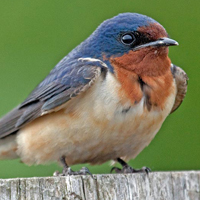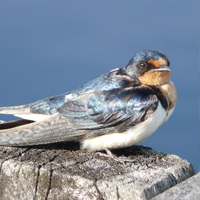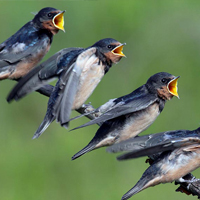Barn Swallow
Scientific name: Hirundo rustica




Photo credits: Mark Peck
Status
Special Concern
“Special concern” means the species lives in the wild in Ontario, is not endangered or threatened, but may become threatened or endangered due to a combination of biological characteristics and identified threats.
Date added to the Species at Risk in Ontario List
January 13, 2012
Read the most recent assessment report (PDF).
What it looks like
Barn Swallow is a medium-sized songbird (about 15 to 18 centimetres long). Males have a glossy steel-blue back and upper wings, a rusty-red forehead and throat, a short bill and a broad blue breast band above its tawny underbelly.
The male has long tail feathers which form a distinctive, deep fork and a line of white spots across the outer end of the upper tail.
The female’s tail feathers are shorter, the blue of her upper parts and breast band are less glossy, and her underside is paler.
Where it lives
Barn Swallow is found across Canada and has been documented breeding in every province and territory, primarily south of the treeline. Barn Swallow also breeds in the United States, Mexico and Argentina.
Barn Swallow is a migratory bird that travels long distances to overwinter in the southern United States, parts of Mexico as well as Central and South America.
Barn Swallows often live in close association with humans, building their cup-shaped mud nests almost exclusively on human-made structures such as open barns, under bridges and in culverts.
The species is attracted to open structures that include ledges where they can build their nests, which are often re-used from year to year.
They prefer unpainted, rough-cut wood, since the mud does not adhere as well to smooth surfaces.
Where it’s been found in Ontario
Barn Swallow is found throughout southern Ontario and can range as far north as Hudson Bay, wherever suitable locations for nests exist.
What threatens it
Threats to the species that result in lower reproductive success and increased mortality include:
- changes to the environment that result in a decrease in the number and quality of flying insects, which are the prey of Barn Swallow
- increased use of pesticides
- changes in agriculture practices
- residential and commercial development
- transportation infrastructure
- climate change
- pollution
The number of Barn Swallows in Ontario decreased by 65% between 1970 and 2019.
Action we are taking
While Special Concern species do not receive species or habitat protection under the Endangered Species Act, 2007, the act requires us to prepare recovery guidance for Special Concern species, unless a recovery strategy or management plan is required for the species under the federal Species at Risk Act.
All species listed on the Species at Risk in Ontario List may be eligible for consideration for government funding through the Species at Risk Stewardship Program.
Recovery guidance
The recovery strategy and government response statement on this page were prepared for Barn Swallow when the species was classified on the Species at Risk in Ontario List as a threatened species.
Now that Barn Swallow has been reclassified as a special concern species, a recovery strategy and associated government response statement are no longer required under the Endangered Species Act, 2007. We are providing these documents here for information and reference purposes.
Recovery strategy
A recovery strategy advises the ministry on ways to ensure healthy numbers of the species return to Ontario.
Read the executive summary (August 13, 2014)
Read the recovery strategy (August 13, 2014)
Government response statement
A government response statement outlines the actions the government intends to take or support to help recover the species.
Read the government response statement (May 13, 2015)
Review of Progress
A review of progress made toward protecting and recovering a species is required no later than the time specified in the species’ government response statement, or not later than five years after the government response statement is published if no time is specified.
Read the report on progress towards the protection and recovery of four species at risk, including Barn Swallow (2020).
What you can do
Report a sighting
- Submit your observations of species at risk to the Natural Heritage Information Centre (NHIC) which is Ontario’s conservation data centre. Join the centre’s Rare Species of Ontario project in iNaturalist, an online plant and animal identification app, to quickly and easily submit your observations.
- Birds Canada is working to advance the understanding, appreciation and conservation of wild birds and their habitat in Ontario and elsewhere. For more information on how you can help, visit Birds Canada’s website.
Volunteer
Volunteer with your local nature club or provincial park to participate in surveys or stewardship work focused on species at risk.
Be a good steward
- Private landowners have a very important role to play in species recovery. If you find species at risk on your land, you may be eligible for stewardship programs that support the protection and recovery of species at risk and their habitats, such as the Species at Risk Stewardship Program.
- If you have buildings such as a shed or barn on your property where Barn Swallows could nest, you can encourage them by creating an opening or leaving a way for them to enter the building. Ledges may be installed if rough vertical surfaces are not available. It is helpful to provide a source of mud near the building entrance, particularly during dry weather.
- As with all wildlife, don’t disturb or harass the birds or nesting sites. Be respectful and observe from a distance.
Report illegal activity
Report any illegal activity related to plants and wildlife to
Quick facts
- According to legend, the Barn Swallow got its forked tail because it stole fire from the gods to bring to people. An angry deity hurled a firebrand at the swallow, singeing away its middle tail feathers.
- Barn Swallows make the long flight to Central and South America each fall, returning to southern Canada – including Ontario – each spring.
- Barn Swallows dart gracefully over fields, barnyards, marshes and open water to hunt for food. They often cruise at high speeds just above the ground or water and make sharp turns, swooping effortlessly to catch flies and other insects. When feeding their young, Barn Swallows fly from before dawn to after sunset, taking only brief rests.
- This species can be beneficial to farmers since they eat large numbers of insects that could otherwise be harmful to crops or farm animals.